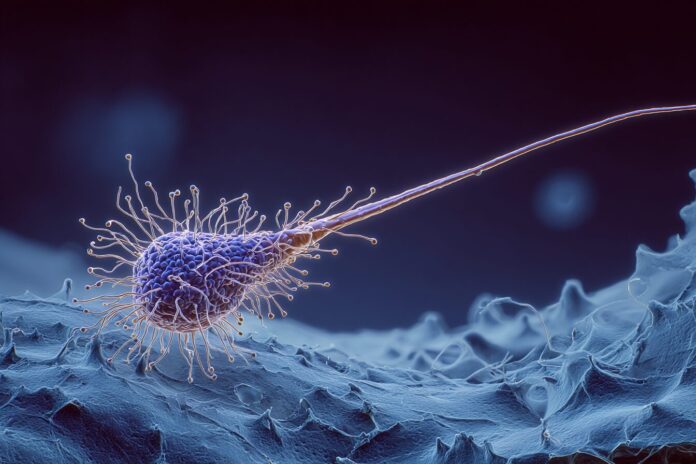Astonishing Discovery at the Heart of the Pacific
Most importantly, a recent scientific breakthrough has stunned virologists worldwide as researchers uncovered PelV-1, a giant virus sporting the longest tail ever documented on a virus. Because this discovery challenges longstanding assumptions about viral simplicity, scientists now have to reevaluate the diversity and complexity of viral structures in the marine realm.
In addition, the discovery took place in a dynamic environment of the Pacific Ocean, where the delicate balance of marine life is continuously observed. Therefore, this breakthrough not only broadens our understanding of virology but also emphasizes the ocean’s relatively unexplored biodiversity. Besides that, the findings have already sparked global interest and discussions regarding the evolutionary implications of such unique viral features.
What Makes PelV-1 Extraordinary?
PelV-1’s main structural feature is its remarkable tail, which is thin yet stretches up to 2.3 micrometers (µm) in length – astonishingly longer than many bacteria. Because viruses are generally minuscule and lack such appendages, PelV-1 stands apart by far. Its viral capsid measures about 200 nanometers wide, an impressive size that dwarfs many common viruses.
Moreover, scientific evidence suggests that this extensive tail may serve as a sophisticated tool for host interaction. Most notably, time-lapse imaging indicates that the tail’s presence is transient, potentially forming only during the initial stages of infection or disassembling once inside the host cell. Consequently, this raises fascinating questions about its functional role and evolutionary purpose. For further details, resources such as the reports on Science.org provide additional context and analysis.
Found in an Unexpected Place: Ocean Plankton
This giant virus was discovered in the North Pacific Subtropical Gyre, specifically at a site north of Hawaii known as Station ALOHA. Because the sampling involved marine phytoplankton, notably Pelagodinium, the discovery has reshaped our views on the ecological roles of oceanic viruses. Most importantly, this finding reveals that even microscopic life forms dwelling in ocean plankton can harbor surprises beyond our current understanding.
Furthermore, the fact that such a massive virus was found inside the marine plankton collection underscores the complexity of ocean ecosystems. Researchers now suspect that similar giant viruses might be hiding in plain sight, waiting to be uncovered. Therefore, continuous exploration is crucial to unravel the hidden viral diversity that exists in these nutrient-rich marine environments. Detailed explorations on this phenomenon have been discussed in sources like ZME Science, adding layers to our comprehension of marine virology.
How Does the Long Tail Work?
PelV-1’s unique tail is not merely for show. Most importantly, the tail appears to attach to the host cell’s surface, potentially aiding in the infection of Pelagodinium cells. Because the tail likely helps with anchoring and penetration, it could be a critical element in the virus’s infection strategy.
Besides that, imaging studies suggest that once the viral material enters the host cell, the tail may disassemble, indicating its role is confined to the extracellular phase. Moreover, the viral genome houses metabolic genes and light-harvesting complexes rarely seen in viruses. Therefore, these characteristics imply that PelV-1 might manipulate the host’s energy dynamics, a finding that holds far-reaching implications for marine biology. Detailed discussions of these potential mechanisms can be found in articles on IFLScience and WION Podcast.
Why Dinoflagellate Viruses Are So Mysterious
Interestingly, only two other large DNA viruses that infect dinoflagellates have been reported, and their genomes remain largely uncharacterized. Most importantly, dinoflagellates are essential drivers of ocean ecosystems, as they form symbiotic relationships that fuel complex food webs and sometimes trigger harmful algal blooms. Consequently, gaining insights into the viruses that infect them, like PelV-1, is fundamental for understanding marine nutrient cycles.
Furthermore, the enigmatic nature of these viruses means that researchers can gain invaluable insights by studying their interactions with host cells. Because the mechanisms remain largely unknown, every new discovery helps fill critical gaps in virology and marine ecology. Therefore, the exploration of dinoflagellate viruses continues to be a top research priority in microbial oceanography.
Implications for Ocean Ecosystems and Viral Evolution
Most viruses are often perceived as simplified and limited entities. However, PelV-1 challenges this conventional wisdom with its giant size, complex genome, and record-breaking tail. Most importantly, the virus’s elaborate structure suggests that the viral world is far more diverse and functionally rich than previously imagined. Because these oceanic viruses likely influence food chains and nutrient cycling, they could serve as pivotal components in maintaining marine ecological balance.
In addition, the discovery prompts scientists to consider the evolutionary pressures that shape such unique structures. Therefore, PelV-1 not only pushes the boundaries of virology but also serves as an impetus to explore the hidden dynamics of marine ecosystems. Articles from Ahmedabad Mirror offer further insights into the potential global implications arising from this discovery.
What’s Next? The Hidden Universe Beneath the Waves
The discovery of PelV-1 is just the beginning. Most importantly, this breakthrough has spurred an intensive search for more giant-tailed viruses in the world’s oceans. Because the oceans cover the majority of our planet, scientists suspect that many more such viral entities remain undiscovered. Therefore, ongoing research and advanced imaging techniques will likely reveal further surprises beneath the waves.
Moreover, each new viral discovery holds promise for a deeper understanding of marine biology and global biogeochemical cycles. Besides that, these findings encourage interdisciplinary collaborations among virologists, marine biologists, and environmental scientists. Consequently, the work continues to reshape our grasp of how microscopic entities influence macro-scale processes such as climate change and carbon cycling. For more on these emerging revelations, viewers are encouraged to check the Science.org article which offers an in-depth exploration into this hidden universe.
References
- Science.org: Giant virus with record-long tail discovered in Pacific Ocean
- ZME Science: Meet PelV-1, the giant virus with the longest tail ever seen
- Ahmedabad Mirror: Giant virus with record-long tail discovered in Pacific Ocean
- IFLScience: Giant Virus With Longest-Ever Tail Lurks In The Pacific Ocean
- WION Podcast: Scientists Discover Virus With Longest Tail Ever Seen



